Childhood education methods in ancient Rome varied greatly depending on social status. The divide between elite vs. commoner households shaped the way children were taught, the subjects they learned, and the opportunities available to them.
- Elite families invested heavily in private education, often hiring skilled tutors and following structured curricula.
- Commoner households relied on informal teaching, with limited access to formal schooling.
- Education in Rome was not just about literacy; it was a tool for social positioning and preparing children for their future roles.
- Social status determined whether a child would study rhetoric and literature or focus on practical skills necessary for everyday life.
Understanding these differences reveals how Roman society reinforced class distinctions through education. The childhood education methods you explore here reflect broader cultural values and economic realities of ancient Rome.
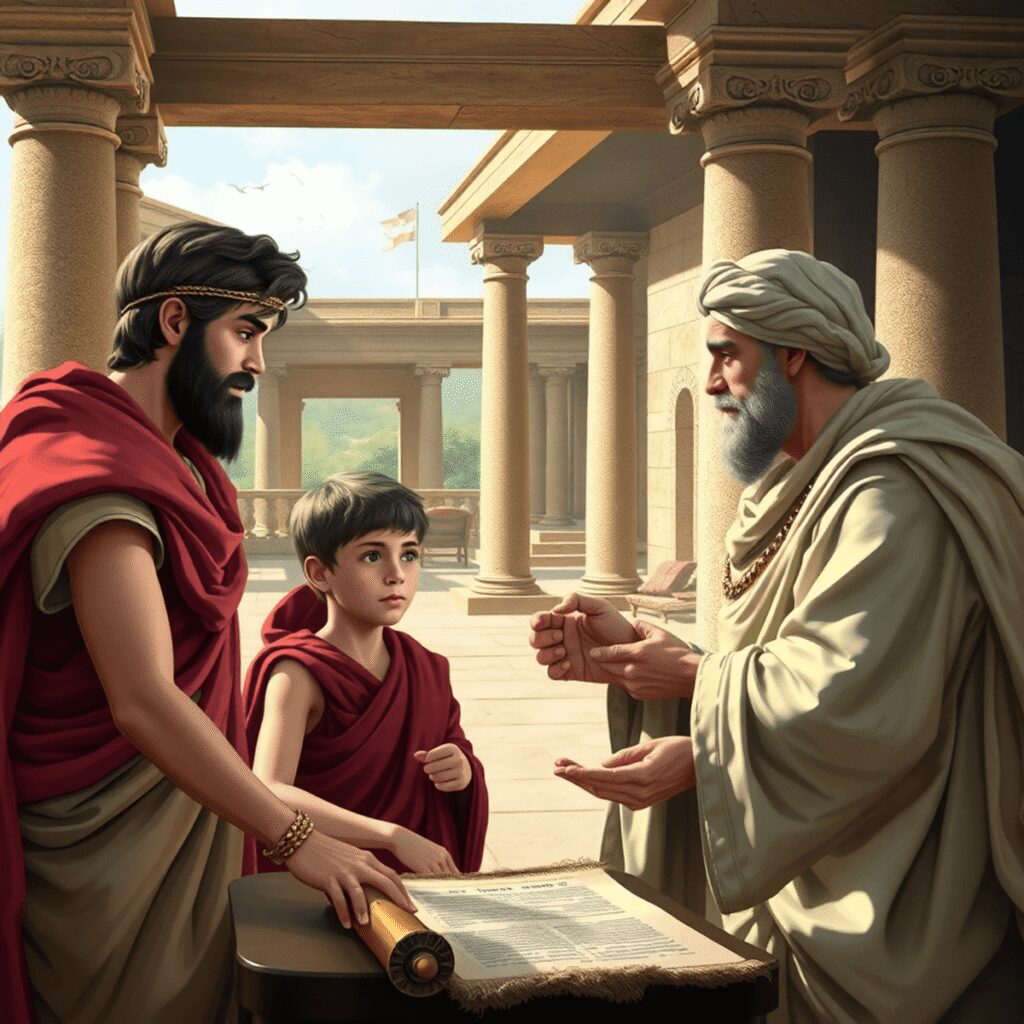
Education in Elite Roman Families
Education in elite Roman families was a carefully crafted process, designed to prepare children—particularly boys—for roles in public life, politics, and administration. The foundation of this education rested on the employment of private tutors, whose background and teaching methods reflected the cultural and intellectual values of the time.
Tutors in Elite Families
Elite households frequently employed tutors who were Greek slaves or freedmen. This practice was not merely a matter of convenience but stemmed from the high regard Romans had for Greek culture and intellectual traditions. Greek education was synonymous with sophistication, philosophical thinking, and rhetorical skill—qualities that Roman elites sought to instill in their children.
These tutors brought with them a curriculum deeply influenced by Greek pedagogy. Their instruction went beyond basic literacy; it included:
- Language mastery: Latin was essential, but fluency in Greek was considered equally important. Many elite Romans spoke Greek as well as Latin.
- Literature: Greek and Roman classics formed the core reading material. Tutors introduced students to epic poetry, drama, and philosophy.
- Rhetoric: The art of persuasive speaking was integral to elite education. Tutors trained boys in public speaking skills crucial for future careers in law or governance.
- Moral philosophy: Lessons often incorporated ethical teachings drawn from Greek philosophers like Socrates, Plato, and Aristotle.
The presence of Greek tutors also meant that Roman education absorbed many educational practices from Hellenistic traditions. These included rigorous memorization techniques, dialectic reasoning exercises, and an emphasis on developing critical thinking alongside rote learning.
Elite families took great pride in their children’s education. The pater familias typically oversaw the tutoring process closely, selecting educators who could uphold the family’s social standing through effective instruction. Tutors were sometimes treated as extended family members but remained firmly under the authority of their employers.
This system allowed elite children access to advanced knowledge and cultural capital unavailable to most Romans. It shaped not only individual intellects but also reinforced social hierarchies by differentiating the educated elite from common citizens.
Such private tutoring created a structured progression for boys—from elementary literacy to sophisticated rhetoric—laying groundwork for public service roles. Girls in these households received education too but followed different paths largely centered on domestic skills and moral training.
Education for Boys in Elite Families
Boys in elite Roman families had a structured and tiered education system that aimed to prepare them for public life and leadership roles. Here’s how the process worked:
Early Education with Private Tutors
The education process began with private tutors, who were often Greek slaves or freedmen. These tutors were responsible for teaching the boys basic literacy skills such as reading, writing, and arithmetic. The initial stage of education focused on these foundational subjects under the guidance of a litterator.
Study of Literature and Language
Once the boys had mastered basic literacy, they moved on to studying with a grammaticus. This instructor introduced them to literature, language, and grammar—both Latin and Greek. During this phase, the boys analyzed poetry, mythology, and classical texts, which reflected the strong influence of Greek educational traditions within elite households.
Advanced Instruction in Rhetoric
The final stage of their education involved advanced instruction in rhetoric with a rhetor. Rhetoric studies were crucial for boys who were destined for political careers or public speaking roles. This curriculum focused on persuasive speaking, debate skills, and legal argumentation. Mastery of rhetoric was seen as essential for participation in Roman civic life.
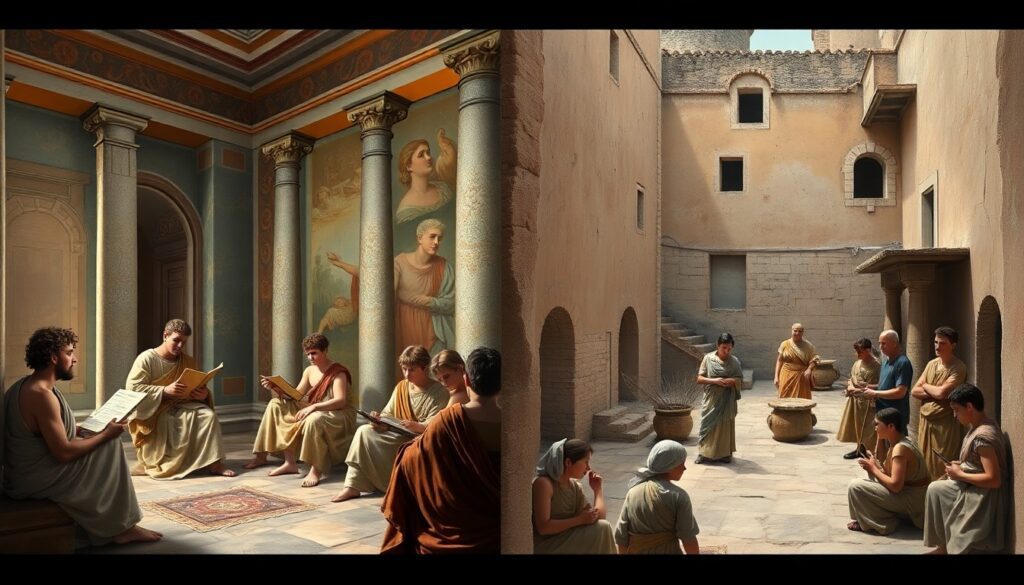
Key Features of Elite Education
The education system in elite families had several key features that set it apart from other households:
- Private and Formal Education: The education received by boys in elite families was primarily private and formal. It took place within the confines of their homes or through specialized schools.
- Role of Tutors and Schools: While private tutors played a significant role in shaping the boys’ education, attendance at tuition-based schools was also common if it was financially feasible.
- Curriculum Focus: The curriculum emphasized subjects such as reading, writing, public speaking, and moral values instilled by the pater familias (head of the family) alongside academic lessons.
- Influence of Greek Pedagogy: Greek pedagogy had a profound impact on the education of elite Roman boys through the presence of Greek slaves and freedmen as tutors.
This comprehensive approach to education set apart childhood learning methods used by elites compared to those employed by commoners in Rome. However, it is important to note that while this education was highly specialized, it also mirrored certain aspects found in other parts of Europe during that period according to some sources, highlighting a broader trend in elite education across different cultures.
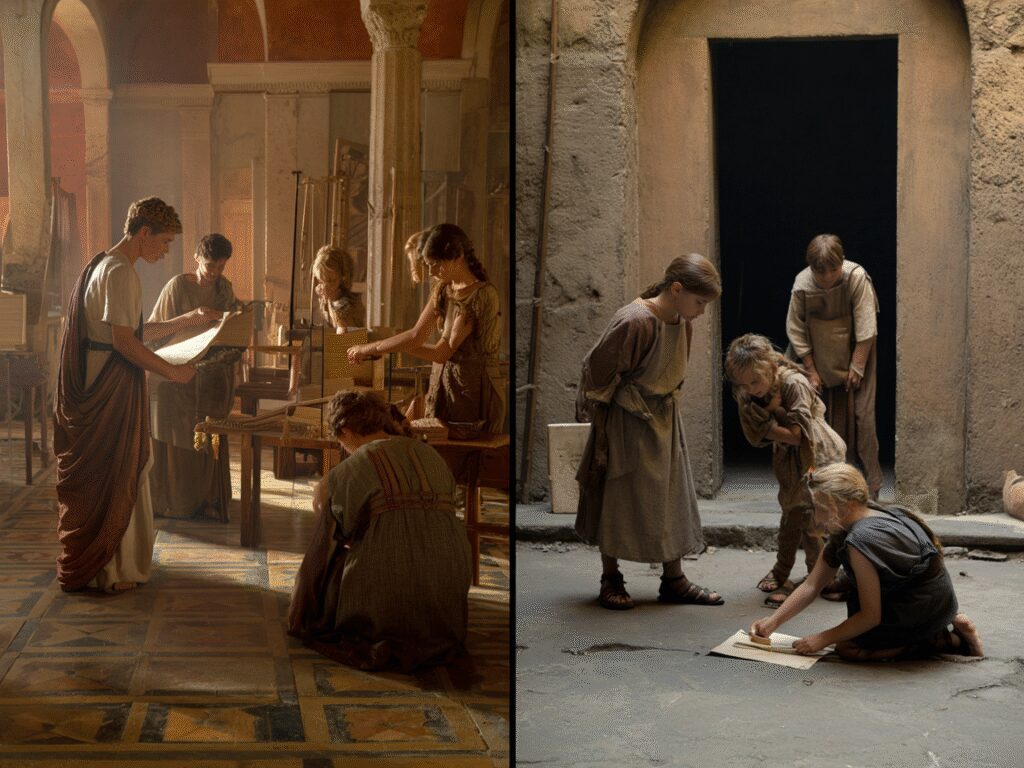
Education for Girls in Elite Families
Girls in elite Roman families received education, but it was distinctly separate from that of boys. Their instruction took place within the private sphere, often overseen by private tutors who were frequently Greek slaves or freedmen, reflecting the strong Greek influence on Roman elite education.
The curriculum for girls generally emphasized:
- Reading and writing: Basic literacy was encouraged to enable girls to manage household correspondence and read religious or cultural texts.
- Moral and domestic instruction: Education aimed to prepare girls for their future roles as wives and mothers, focusing on virtues like pietas and modesty.
- Household management skills: Girls learned skills necessary to run a prosperous Roman household, including knowledge of weaving, spinning, and supervising slaves.
- Limited public speaking or rhetoric: Unlike boys, girls rarely engaged in formal rhetoric training or public speaking exercises.
Education was private and formal but tailored to reinforce gender roles within elite society. Although tuition-based schools existed, girls typically remained educated at home or in small groups, reflecting societal expectations that prioritized their domestic responsibilities over public careers.
This separate educational track ensured that while elite girls were literate and culturally refined, their instruction remained focused on preparing them for marriage alliances and managing family estates rather than pursuing political or legal careers.
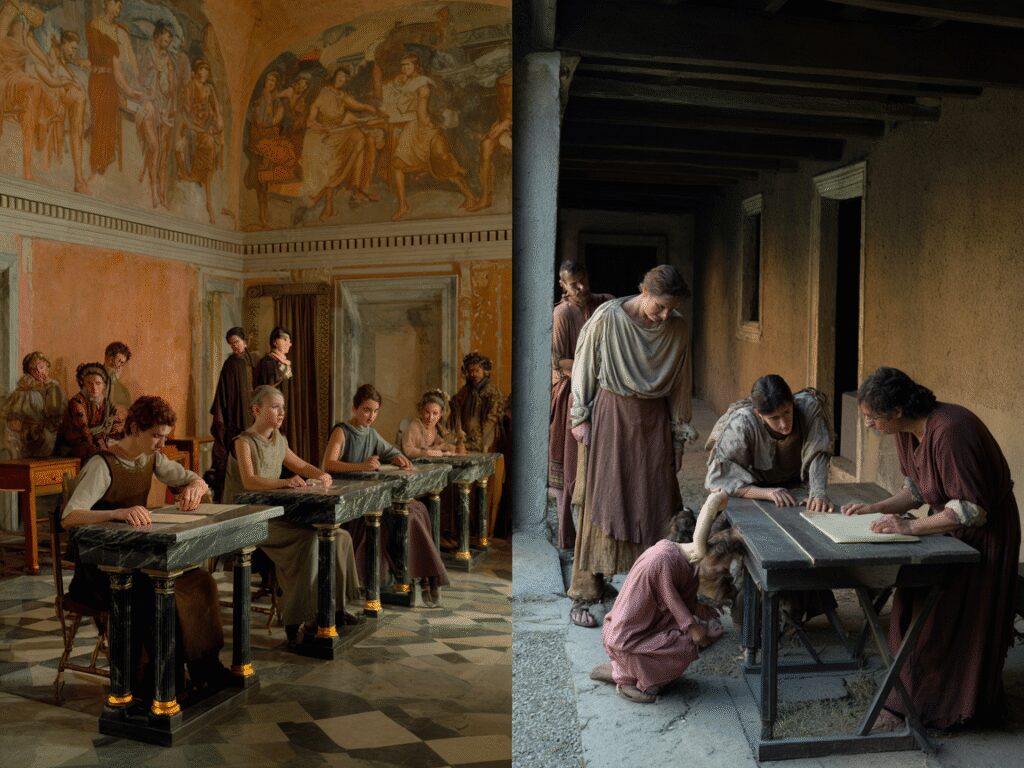
Education in Commoner Households
In commoner households in ancient Rome, education took on a more informal and practical approach compared to the structured and formal education seen in elite families. Here’s a look at how childhood education differed for commoners:
Lack of Public Education for Commoners
- Public or free education was a rarity for commoners due to financial constraints.
- Most commoners could not afford tuition fees required for formal schooling, leading to limited access to educational opportunities.
Informal Education at Home
- Children in commoner households often received basic education from their parents at home. This type of learning, known as informal education, was prevalent.
- Skills such as reading, writing, arithmetic, agricultural work, and domestic tasks were taught to prepare children for daily life.
Apprenticeships
- Many children of commoners transitioned into apprenticeships rather than pursuing further formal education.
- Hands-on training and learning through apprenticeships provided practical skills necessary for future employment.
Focus on Practical Skills
- Commoner girls were typically educated with a focus on marriage preparation and household management skills.
- Emphasis was placed on skills that would be beneficial in maintaining a household and supporting a family.
Limited Access to Higher Education
- The lack of public education and the financial barriers restricted commoners from accessing advanced levels of schooling.
- Higher education, similar to that received by elite families, remained out of reach for most commoner children.
Childhood education in commoner households was characterized by informal learning at home, practical skill development through apprenticeships, and a focus on preparing children for their future roles within the family. The limited access to public education and the inability to afford tuition fees meant that most commoner children did not receive the same level of formal education as their elite counterparts.
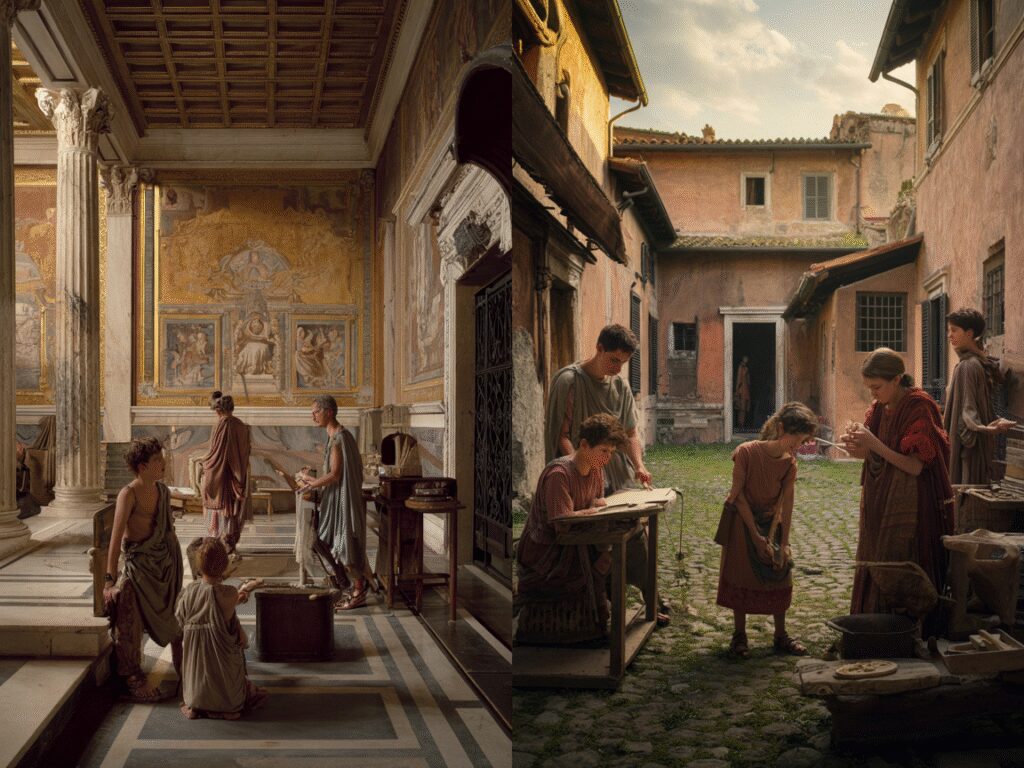
Education for Girls in Commoner Households
In commoner households in ancient Rome, education for girls was vastly different from that in elite families:
- Less Formal Education: Commoner girls received less formal education compared to their elite counterparts.
- Focus on Marriage Preparation: The primary focus of education for commoner girls was centered around preparing them for marriage.
- Household Management Skills: Girls in commoner households were taught essential household management skills to fulfill their future roles as wives and mothers.
- Informal Education: Education for commoner girls was often informal, with parents teaching practical skills needed for daily life.
- Limited Access to Formal Education: Due to financial constraints, commoner girls had limited access to formal schooling beyond basic literacy and numeracy.
- Apprenticeships: Many commoner girls would transition into apprenticeships or practical training instead of pursuing further formal education.
This contrast highlights the significant disparity in educational opportunities between elite and commoner households in ancient Rome, with commoner girls primarily groomed for domestic roles rather than intellectual or public pursuits. This situation was not unique to Rome; similar patterns can be observed in other ancient civilizations as well, such as the Mayan civilization, where education for girls also focused more on domestic skills rather than formal academic learning.
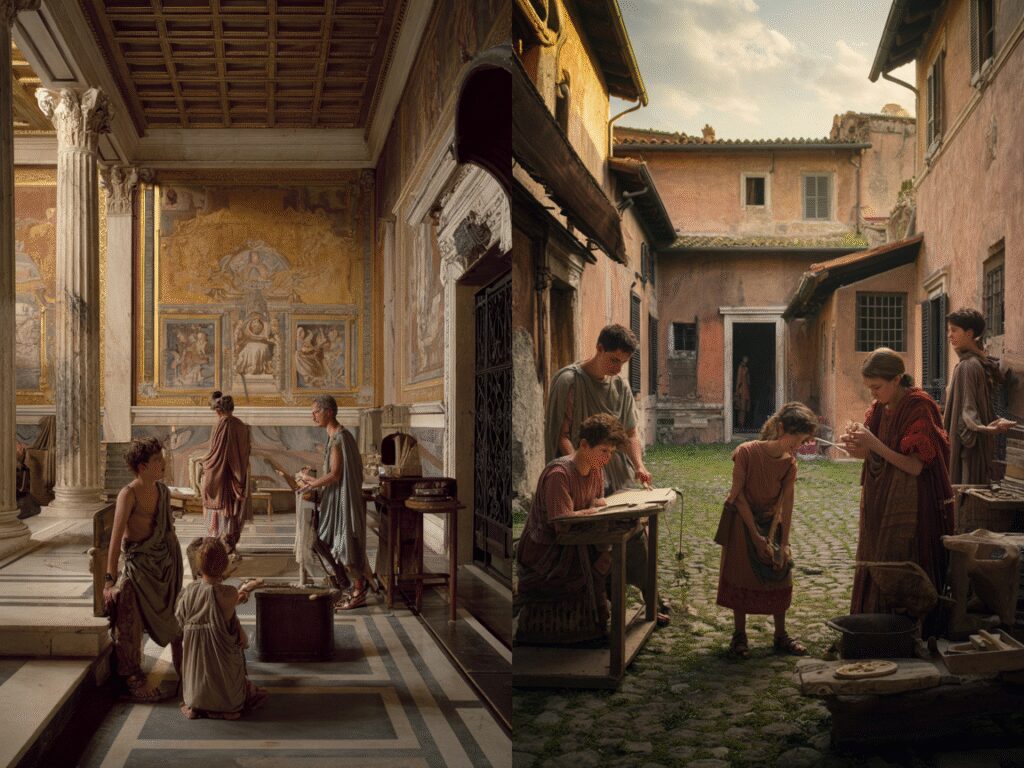
Evolution of Roman Educational System
The development of childhood education methods in elite vs. commoner households in Rome highlights a significant shift from informal family-based teaching toward a more structured educational system. This transformation was driven largely by the influence of Greek teaching methods on Roman elite education.
Influence of Greek Teaching Methods
Greek tutors introduced systematic curricula emphasizing literature, rhetoric, and philosophy, replacing the earlier, more casual transmission of knowledge within the family. These methods formalized instruction with specialized roles such as the litterator (elementary teacher), grammaticus (teacher of grammar and literature), and rhetor (teacher of rhetoric) guiding boys through stages of learning.
Social Class Distinctions
Access to advanced educational opportunities remained tightly controlled by wealth and status, reinforcing social hierarchies. Elite children enjoyed comprehensive schooling designed for leadership roles, while commoners had limited or no access beyond basic skills.
Education became a tool not only for intellectual growth but also for maintaining societal structures, with restricted access ensuring the persistence of class divisions across generations.
This dual-track system illustrates how education in ancient Rome was both a cultural inheritance and an instrument of social stratification.

